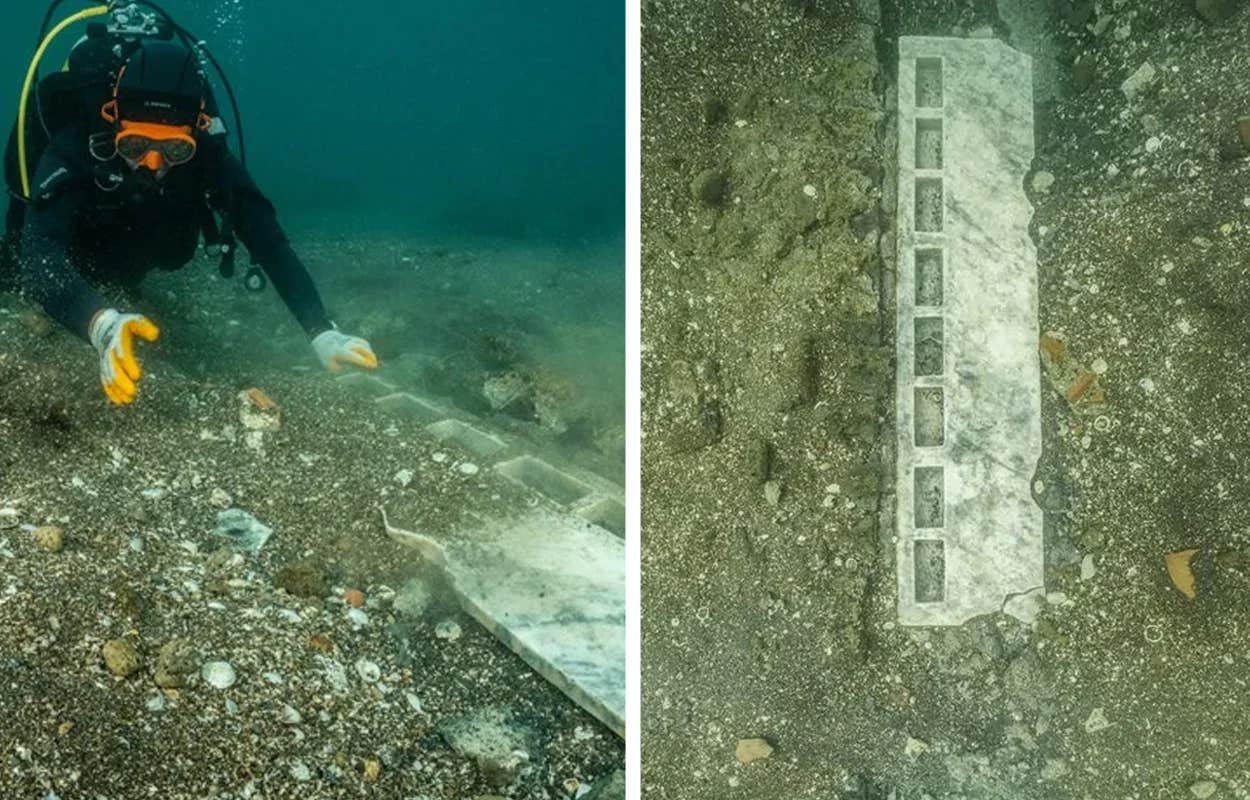2,000-year-old lost temple found submerged off the Italian coast
An ancient Nabataean temple found in Pozzuoli, Italy, reveals Roman architectural influence and cultural fusion in this submerged port city.

The discovery of a submerged Nabataean temple in Pozzuoli, Italy, reveals a 2,000-year-old blend of Roman and Middle Eastern cultures. (CREDIT: Ministero della cultura)
A recent discovery has brought new light to an ancient Mediterranean port and its role in cross-cultural exchanges. Near Naples, Italy, archaeologists have uncovered a 2,000-year-old Nabataean temple off the coast of Pozzuoli, once the Roman city of Puteoli.
This discovery adds a remarkable chapter to the history of Nabataean civilization, a culture best known for the rock-carved monuments of Petra in Jordan. Yet, here in Pozzuoli, the Nabataeans left their mark with a temple built in Roman architectural style but dedicated to their supreme god, Dushara, offering a blend of cultural influences that was largely unexpected.
The findings are the result of the "Between Land and Sea" project, a collaboration involving the Italian Ministry of Culture and the University of Campania. The project has focused on the ripa Puteolana, a 2-kilometer stretch of submerged Roman structures that once formed part of Puteoli's bustling port system, one that connected Mediterranean trade routes.
Puteoli was a major entry point for goods like grain from Egypt and North Africa, and its infrastructure reflected its prominence, including extensive warehouses and elaborate buildings. However, volcanic activity ultimately submerged these structures, preserving them under the sea.
In 2023, during the documentation of the submerged port, archaeologists identified the remnants of a Nabataean sanctuary, an unexpected find as Nabataean architecture is generally confined to the Middle East.
Lead researcher Michele Stefanile noted, “For me this was one of the most unexpected discoveries.” His team, mapping the seafloor, documented the temple's layout, featuring two rooms lined with marble altars. Each altar was inscribed with the phrase “Dusari sacrum”—Latin for “consecrated to Dushara”—confirming the building’s purpose as a place of worship for Nabataean deities. The inscriptions also mark a rare use of Latin for Nabataean religious sites, a shift likely reflecting the community’s immersion in the Roman world.
Archaeologists used a photogrammetric survey to create detailed reconstructions of the temple's architecture. They found two distinct rooms, designated Room A and Room B, each demarcated by sturdy opus reticulatum walls—a style characteristic of Roman construction.
Related Stories
In Room A, two marble altars remain in place against the southern wall. One altar, measuring 1.6 by 0.65 meters, features eight recessed spaces thought to hold aniconic betils, or sacred stones, typical of Nabataean worship. These stones, unlike traditional religious icons, symbolized divinities without depicting their forms, allowing worshipers to honor Dushara through a uniquely Nabataean lens.
Along the southern wall, white marble slabs with the dedication “Dusari sacrum” provided further confirmation of the temple's purpose.
Near the southeast corner of Room B, archaeologists found a concrete block structure, likely a plinth, covered with cocciopesto, a waterproof Roman mortar. This discovery suggested that the temple had undergone modifications, with researchers noting that a small basin had been added next to the plinth at a later date. The plinth and surrounding mortar surfaces could have served ritual purposes, potentially for offerings or ablutions, enhancing the temple’s role as a site of devotion.
The discovery not only reveals architectural details but also speaks to the lives of the Nabataean merchants who thrived in Puteoli. Under Augustus's rule from 31 BCE to 14 CE, Rome had fostered a golden age of economic freedom for its allies, allowing the Nabataeans to integrate and flourish within Roman society.
Nabataean merchants at Puteoli benefited from Rome's vast trade network, dealing in valuable goods like spices and silk from the Indian Ocean. Their temple, built with locally sourced materials, reflects this integration: tuff and pozzolana stones were abundant in the region, while expensive Luni marble—likely imported—covered parts of the walls and altars. Roman influence is evident in the Augustan style of the altars and the use of Latin, suggesting a desire by the Nabataean community to communicate across cultural boundaries.
The sanctuary not only served as a religious space but also as a social and economic hub, where the Nabataean god Dushara provided symbolic protection over trade activities. Roman historian Michele Stefanile stated, “It seems that we have a building dedicated to the Nabataean gods, but with Roman architecture and Latin inscription,” emphasizing the blending of traditions.
However, this golden age was not to last. After Trajan’s conquest of the Nabataean Kingdom in 106 CE, the region was absorbed into the Roman province of Arabia Petraea, shifting control of trade networks away from local communities. As a result, the once-prosperous Nabataean merchants gradually lost their economic autonomy.
The temple itself reflects this change. In the early second century CE, rather than desecrating the site or dismantling the sacred stones, Nabataean worshipers chose to preserve the temple by filling it with concrete and other materials. This act may have stemmed from Rome’s respect for consecrated sites, which often prevented outright destruction.
Instead, the temple was entombed, left intact under a new floor as Puteoli continued to grow around it. Layers of amphorae fragments from Dressel 2–4, commonly used during the first century, suggest that this filling process likely occurred shortly after Rome annexed Nabataea, around 106 CE.
The final resting place of the temple's sacred stones is unknown, though the decision to fill the temple may have been influenced by a desire to preserve its sanctity even as Roman authorities reshaped the port.
The Nabataean presence in Puteoli represents a brief yet impactful moment of cultural fusion and economic vitality. Archaeologists, as they explore this submerged world, continue to uncover the stories of those who lived, worshiped, and traded within its walls. The 2024 planned excavations aim to reveal more about the temple and its connections to Nabataean culture.
This submerged sanctuary in Pozzuoli reveals not only the Nabataean adaptation to Roman customs but also the endurance of their traditions within a new world. Their choice to construct a temple in the heart of Roman trade exemplifies a commitment to cultural heritage and a willingness to integrate.
Today, this unique find in the Gulf of Pozzuoli preserves the memory of a people who once bridged the worlds of the East and West, leaving behind a legacy that has now, quite literally, resurfaced.
Note: Materials provided above by The Brighter Side of News. Content may be edited for style and length.
Like these kind of feel good stories? Get The Brighter Side of News' newsletter.



